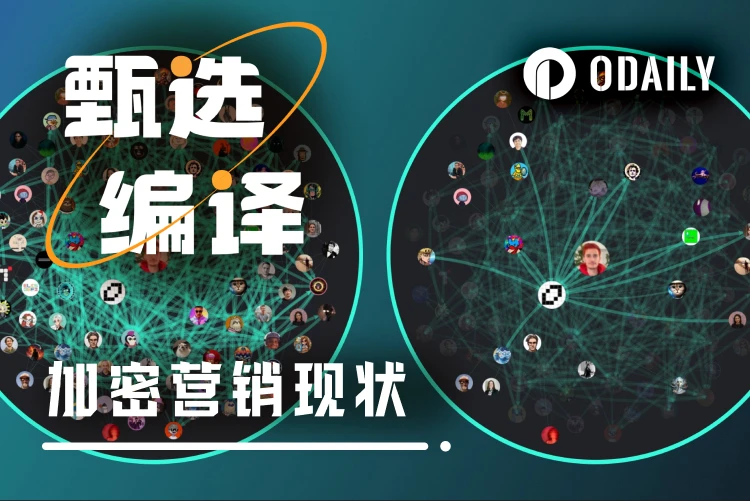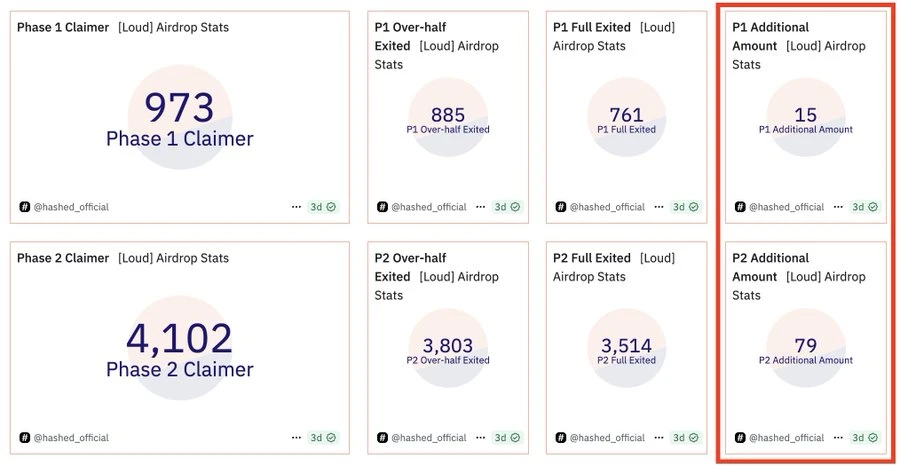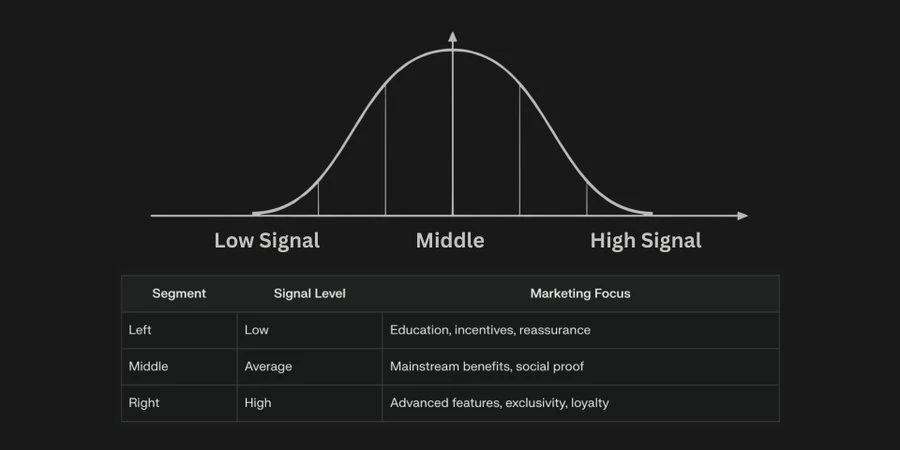Original Author | Brain (@BrianAitch)
Compiled by | Odaily Planet Daily (@OdailyChina)
Translator | Dingdang (@XiaMiPP)

Editor’s Note: The "mouth economy" is at the forefront, becoming a hotbed for retail investors and project parties to engage in a game of strategy. However, this "mouth economy" craze is currently facing severe challenges: the proliferation of low-quality content, rampant click-fraud behavior, and users' growing fatigue towards "reward-driven" tactics have led to a continuous decline in conversion rates. Taking Loudio as an example, its market value plummeted from $98 million to $3,800 within 25 days, exposing the vulnerability of the "mouth economy" that overly relies on noise marketing. This article analyzes the pain points of the current "mouth economy," explores its impact on crypto project marketing, and rethinks the fundamental limitations and improvement space of current crypto project marketing.
1. Inefficient Marketing Cost
Most projects invest heavily in marketing collaborations similar to Kaito. Just to launch Kaito Earn, they need to prepay hundreds of thousands of dollars, followed by monthly investments of equivalent tokens or dollars.
Kaito can indeed play a role in brand exposure and topic generation; however, most of these interactions are driven by "hired" content creators with limited influence, resulting in overall low quality and signal strength.
What projects truly want are high-quality dialogues that can resonate with the community, convey brand values, and ultimately achieve effective conversions. Yet, such dialogues are few and far between.
2. Evaluating Marketing Effectiveness from Conversion Rate Data
Crypto projects typically have two main goals:
Increase the number of product users
Boost token prices (i.e., have more token buyers after TGE)

(Data Source: Dune @hashed_official)
Taking Loudio as an example:
Among the first phase participants, the proportion of those who received additional quotas is about 1.54% (15/973)
The second phase is 1.93% (79/4102)
In comparison, Google Ads has a conversion rate of about 4.29% ~ 6.96%
In other words, Loudio's overall conversion rate is far below that of traditional digital advertising.
3. The "Noise" Problem Caused by Lack of Substantive Content

Many brands allocate a large portion of their marketing budget to create "hype" on X, especially relying on InfoFi platforms. However, without substantive content, these marketing outputs will ultimately devolve into meaningless noise.
Quoting @Chilearmy123:
Even if project K announces that it will distribute over $15,000 in rewards to Kaito users each month, the public will only remember that "Project K is very generous." If it launches a "mascot meme coin" and adopts a distribution method similar to Loudio, people will naturally start discussing its significance, community culture, user experience, and other content.
Therefore, rather than relying on platform tools, it is better to choose clear themes and specific incentive mechanisms, such as games, meme coins, or DApps. These topics are more likely to spark active discussions among users and lead to high-quality conversions.
If a project relies solely on incentive mechanisms to attract early users on the left side of the marketing curve but lacks substantive content, these individuals will ultimately find it difficult to convert and move to the next stage.
4. Returning to the Fundamentals of Products and Teams
Using @leonabboud’s metaphor:
A project is an instrument, and marketing is the amplifier or sound system.
Many teams try to use a larger "sound system" to cover up the "out-of-tune instrument" (an imperfect product) and the "technically deficient performer" (an underqualified team).
While this can increase exposure in the short term, if the project itself lacks fundamental skills, even popular tools like Kaito cannot deliver ideal results.
As the crypto industry matures and participants become more professional, believing that "spending money to buy hype" can bring real value underestimates the wisdom of the market and users.
5. Structural Contradictions of InfoFi
The misalignment between InfoFi platforms and crypto projects in terms of incentive structures and goals is becoming increasingly apparent.
InfoFi platforms seek to: attract more incentives (such as USDC, project tokens), take commissions, distribute rewards, and expand the user pool;
What project parties truly care about is whether users will: genuinely use the product or continue to purchase tokens after TGE.
Currently, most activities on InfoFi are still dominated by "hired" creators, whose limited influence results in overall conversion rates that are even lower than traditional advertising channels.
In my view, platforms that can succeed in this round of InfoFi competition need to address the following two core issues:
Empower high-signal, high-quality creators to drive genuine community-driven dialogues;
The platform's incentive structure must align with the project's incentive goals, as the rewards provided by project parties are the fuel for InfoFi's operation.
We are already seeing early signs of this trend, indicating that InfoFi is moving towards a more sustainable and effective development stage.
Case Studies
Virtuals
Although Virtuals is not an InfoFi platform, the data shared by its co-founder @ethermage reflects a high level of attention to "conversion rates" and "incentive mechanisms":
About 35% of Genesis participants made additional purchases of tokens in the secondary market.
The team is optimizing the distribution mechanism, leaning towards rewarding steadfast holders, especially those who double down on their beliefs.
This approach reflects the industry's gradual alignment towards "conversion-oriented + long-term value creation."
Kaito
Kaito is actively responding to community feedback and updated its algorithm on June 17, with major changes including:
1) Quality vs Quantity: Posts that only mention rewards or rankings without valuable insights or project reviews will no longer receive attention;
2) Attention Distribution Mechanism: To prevent any single piece of content from being overly promoted, there is a cap on the total amount of attention that can be gained in each cycle, and a single tweet cannot hold too much weight;
3) Anti-"Small Circle" Mechanism: The platform closely monitors internal interaction behaviors and has strong protective mechanisms to curb click fraud and "group scoring" behaviors;
4) Loyalty Incentives: The platform encourages users to maintain long-term, continuous value-oriented participation while avoiding punitive restrictions on broad participation behaviors;
5) Team Control: Project teams can customize the maximum attention contribution of tweets each week, enhancing platform flexibility.
Since the launch of Kaito Earn, it has consistently focused on user conversion. This is evident in the data shared by @MagicNewton:
There are currently 33,699 agent accounts activated through Kaito, accounting for about 30% of Newton's total activity. These agents generate continuous fee income for Newton by purchasing BTC, KAITO, and other assets. The number of activated agents is still steadily increasing.
To comprehensively assess Kaito's effectiveness in the "conversion engine," attention should be focused on the following key metrics:
Retention rate of agent accounts after TGE
The ratio of fee output from Kaito Earn to platform expenditure
Among users participating in Kaito Earn, how many made additional purchases of tokens in the secondary market
While more time and data are needed to draw final conclusions, it is clear that Kaito has a clear understanding of the importance of conversion rates and is continuously optimizing its algorithm based on community feedback.
Clout
Kaito is not the only InfoFi project adjusting its algorithm to enhance conversion efficiency. On June 25, 2025, @fantasytop launched Clout Pro and collaborated with @monstersdotfun to kick off Week 0 activities.
Clout Pro is an API and SDK for tracking attention, helping project parties quickly build leaderboards and identify the most active users.
Key features include:
Anti-manipulation Protocol: Built-in mechanisms to prevent click fraud, farms, and false interactions;
Customizable Analysis Tools: Support for sentiment filtering, keyword recognition, anti-farm mechanisms, etc.
After distributing tokens and points, the platform will focus on monitoring the proportion of users making additional purchases of tokens. This mechanism is more complex than Loudio, as it is influenced by multiple factors such as NFT, Abstract levels, Ethos scores, and tokens.
Notably, the Clout team is continuously optimizing its social and incentive algorithms and providing customized support for project parties. This flexible mechanism is expected to enhance conversion rates, but the ultimate effect still depends on the alignment of execution and strategy.
Currently, there are other platforms like @cookiedotfun Snap participating in the competition within the InfoFi ecosystem. While it is still impossible to determine who will ultimately prevail, it is certain that:
Whoever can provide the largest reward pool, the most refined incentive alignment mechanism, and achieve genuine user conversions will stand out in this round of the InfoFi cycle.
6. Conclusion: What You Need Is Not a Bigger Horn, But a Better Melody
Marketing is only effective when the fundamentals of the project, namely the product, information, and community, are solid.
What we truly need is more beautiful music, not just louder sound systems.
InfoFi platforms should focus on helping projects improve conversion rates, whether by increasing platform user numbers or driving secondary market token purchases.
The key to success is not to cover the widest audience but to effectively convert the audience.
InfoFi platforms that can precisely align incentive structures with project goals, provide ample reward pools, and attract high-quality creators are most likely to win in this game.
I am also a staker of Kaito. If you disagree, you might be right.
Attention is not everything.
免责声明:本文章仅代表作者个人观点,不代表本平台的立场和观点。本文章仅供信息分享,不构成对任何人的任何投资建议。用户与作者之间的任何争议,与本平台无关。如网页中刊载的文章或图片涉及侵权,请提供相关的权利证明和身份证明发送邮件到support@aicoin.com,本平台相关工作人员将会进行核查。



